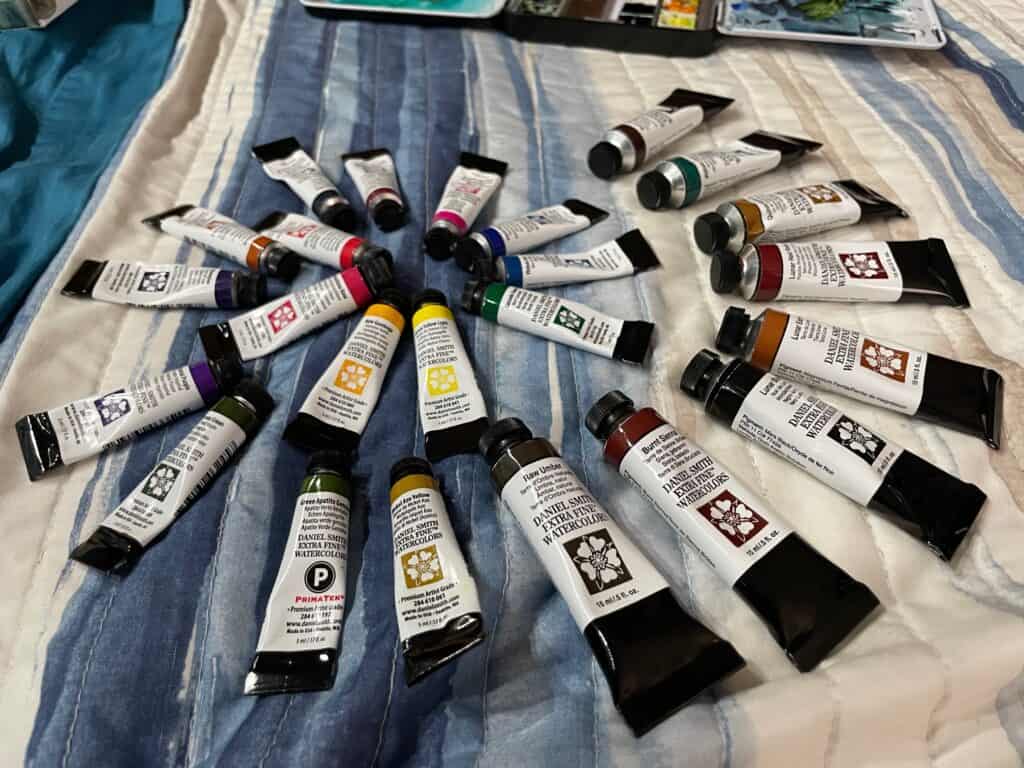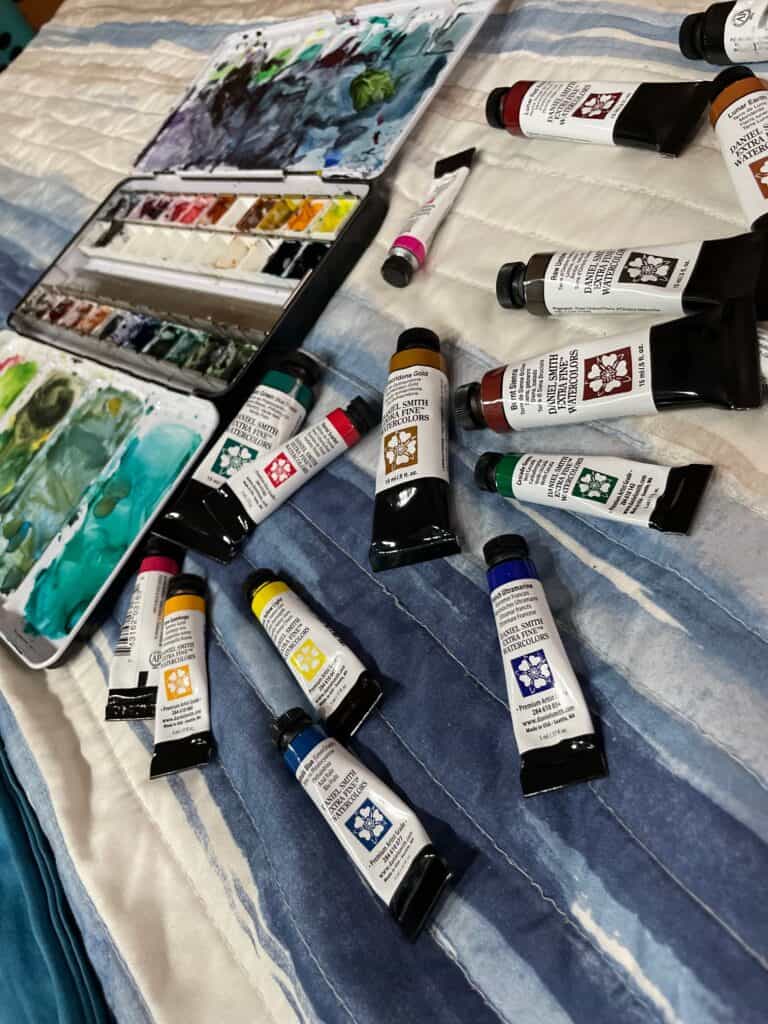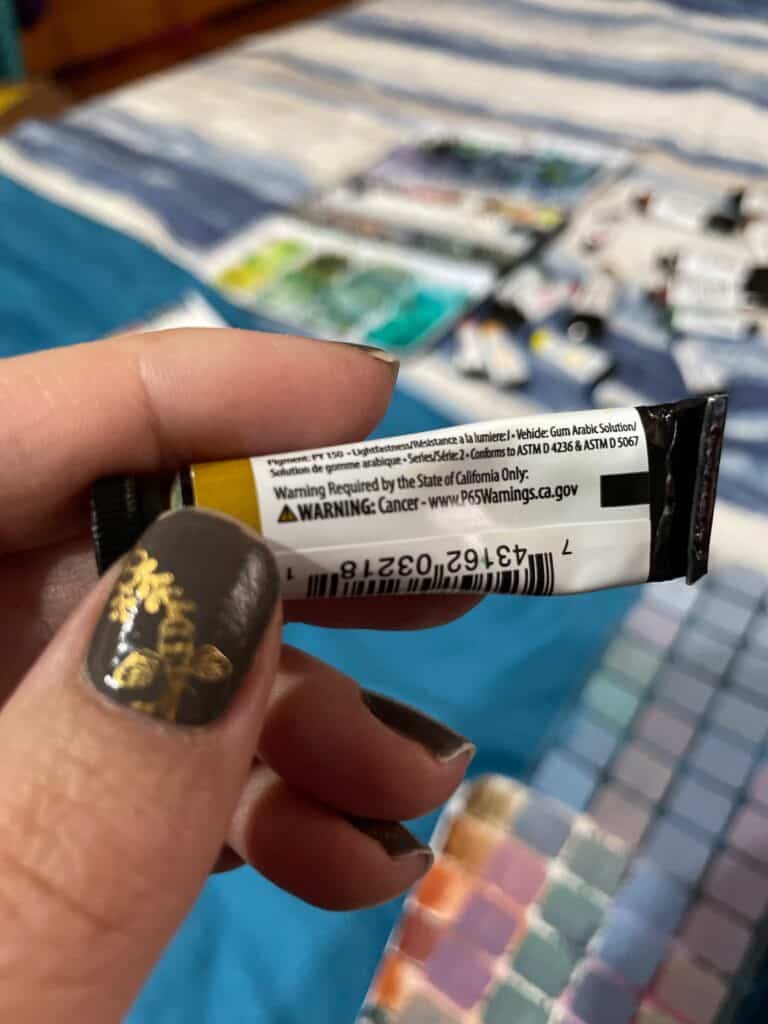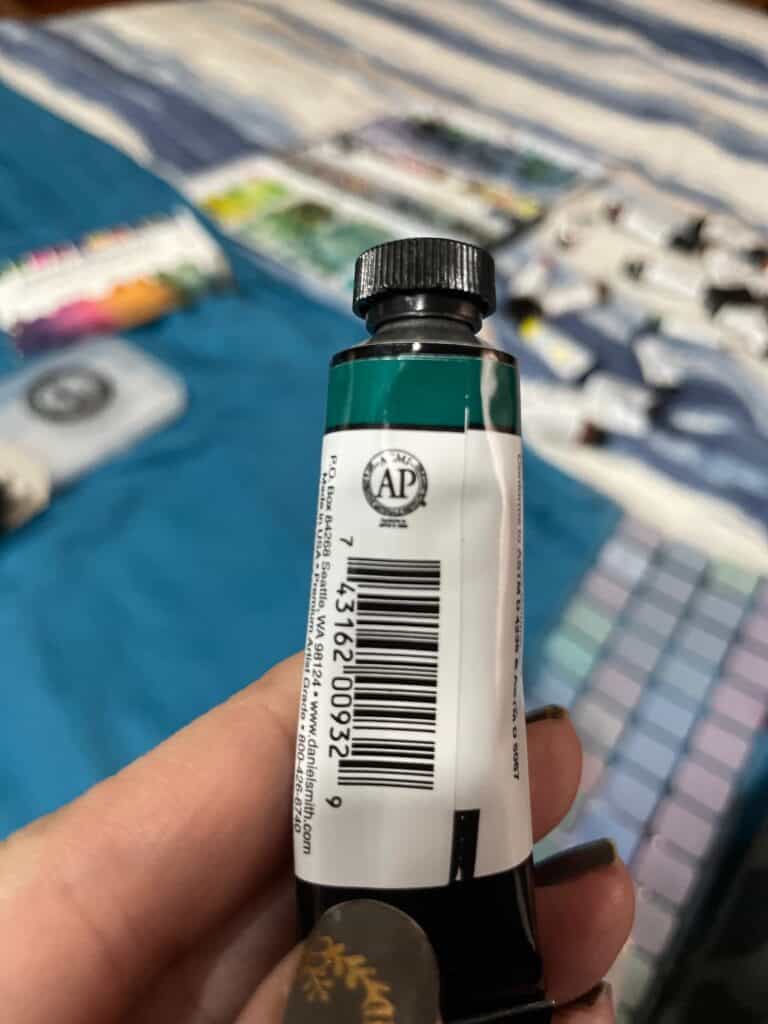Exploring Dynamic Watercolor Paint

I independently review every product I recommend. When you make a purchase through a link, I may earn a small commission at no additional cost to you. Learn more
Discover Dynamic Watercolor Paints
Thank you for meeting me AT FORESTS EDGE, today’s journey is a discovery of WATERCOLOR PAINT. Ah, the world of watercolor paints! It’s a realm where colors flow like stories waiting to be told, where your imagination pirouettes with a paintbrush, and where the canvas is a stage for your artistic adventures. If you’re new to this colorful wonderland, welcome my friend! We’re about to embark on a brilliant journey discovering what watercolor paint actually is, and the different options available to you.
The Allure of Watercolor Paints
Watercolor paints, my dear artistic soul, are a breed of their own. They have a unique charm, like an old book with pages filled with tales yet to be discovered. It’s no wonder they’re often described as “transparent poetry.” There’s a certain elegance in the way they seamlessly blend and dance across the paper.
I like to imagine myself as the storyteller, with a palette of vibrant characters at my disposal. These colors have personalities of their own, waiting for you to bring them to life.
In this article, I will unveil the secrets of watercolor paints. Think of me as your trusty guide as you navigate the world of pigments and binders, and professional and student-grade watercolor paints. Not to forget, a friendly reminder to stay safe while you embark on this artistic journey. So, get ready to dip your toes (and your brushes) into the sparkling waters of watercolor paints, where every stroke is an adventure and every artwork is a story waiting to be told.
The Unique Charm of Watercolor Paints

Picture this: you’ve got a fresh sheet of watercolor paper in front of you, a pristine canvas awaiting your touch. You dip your brush into a puddle of vibrant, translucent paint, and as it meets the paper, something magical happens. The colors flow and mingle like old friends, creating soft transitions and captivating gradients. This, my fellow artist, is the enchanting allure of watercolor paints.
What makes watercolors so special?
- Transparency: Watercolors are like the whisper of colors on paper. They let the white of the paper shine through, giving your artwork a luminous quality. It’s almost as if you’re painting with light itself.
- Vibrancy: These paints may be transparent, but they pack a punch of color. The pigments when concentrated are vivid, ready to create intense, eye-catching hues.
- Versatility: Watercolors are as versatile as your imagination. You can achieve delicate washes, intense layers, and everything in between. The same tube of paint can produce a soft pastel or a bold, rich tone, depending on how you use it.
So, why the comparison to storytelling? Well, every brushstroke you make with watercolor paints is like a sentence in your artistic narrative. Each layer is a plot twist, and the blending of colors is where your story takes a turn. Just as a masterful storyteller knows how to weave words into captivating tales, you, my friend, will weave colors into mesmerizing works of art.
Transparency and Brilliance: Watercolor Paints Unveiled
Watercolors are often described as “transparent poetry,” and it’s a fitting metaphor. The transparency of these paints allows the underlying paper to shine through, giving your artwork a delicate, ethereal quality. It’s like adding a layer of intrigue to your masterpiece, making viewers feel like they’re peering into a magical world.
But don’t let the term “transparency” fool you into thinking watercolors lack brilliance. As a matter of fact it is quite the opposite! These paints are anything but shy. They possess a unique vibrancy that can make your artwork spring to life. The pigments are bold, and intense, and, when handled with care, they create striking, luminous colors that catch the eye and tug at the heartstrings.
Pigments and Binders: The Artistic Alchemy of Watercolor Paints
Pigments: The Colors of the World
If watercolor paints were the characters in your artistic story, pigments would be the vibrant personalities that breathe life into each one. Pigments are the heart and soul of watercolors, and they’re derived from a variety of sources.
Sources of Watercolor Pigments
- Minerals: Some pigments are mined from the earth. Think of them as solid, reliable characters in your story. Colors like Burnt Sienna and Ultramarine Blue are often made from minerals like sienna and lapis lazuli.
- Plants: Other pigments are extracted from the plant kingdom. These are like the botanical characters that bring life and freshness to your narrative. Colors like Sap Green and Alizarin Crimson are often made from plants like buckthorn and madder.
- Insects: Pigments made from insects are usually red in color and created from a type of scale insect. Carmine is one of those pigments that has been used for over 2,000 years. Its light fastness is not the best. I actually studied the source of the red pigment scarlet this past week while I was studying Proverbs 31.
- Synthetic Compounds: Modern chemistry introduces a cast of synthetic characters into the mix. These pigments are like the futuristic heroes in your story, created in labs to provide brilliant, consistent colors. Colors like Phthalo Blue and Quinacridone Magenta are examples of synthetic pigments.
Each pigment has its unique characteristics, like characters with their own quirks and strengths. Some are transparent, while others are more opaque. Some granulate beautifully, creating fascinating textures, while others flow smoothly like silk on paper.
Common Pigments in Watercolor Paints:
- Cadmiums (Cadmium Yellow, Cadmium Red)
- Cobalts (Cobalt Blue, Cobalt Violet)
- Quinacridones (Quinacridone Magenta, Quinacridone Gold)
- Phthalos (Phthalo Blue, Phthalo Green)
- Earth Colors (Burnt Sienna, Raw Umber)
- Ultramarine Blue
- Alizarin Crimson
- Sap Green
Binders: The Glue That Holds it All Together
If pigments are the characters, binders are the glue that weaves them into a cohesive narrative. Binders are the substances that hold pigments together, allowing them to be suspended in water and applied to paper.
Common Watercolor Binders:
- Gum Arabic: This is the most common binder in watercolors. It’s a natural sap from the acacia tree and has been used for centuries. Gum arabic provides a stable, flexible film, making it a reliable choice for watercolor paints.
- Honey: Some watercolor manufacturers use honey as a binder. Honey makes the paint creamy and slow-drying, allowing for better control over wet-into-wet techniques. It’s like the sweet twist in your artistic story.
- Glycerin: Glycerin is another binder used in some watercolors. It slows down the drying time, making it easier to re-wet the paint for touch-ups. Think of it as the patient character that ensures your story unfolds at just the right pace.
With this comprehensive list of pigments and binders, you have a better understanding of the colorful ingredients that make up watercolor paints. The right combination of pigments and binders can help you paint your artistic stories on paper.
Painting Ingredients as an Artistic Narrative
So, what does all this have to do with your watercolor painting journey? Just like an author selects characters and weaves them into a story, you, the artist, choose pigments and binders to craft your visual narrative.
Different pigments and binders provide unique qualities to your paint, influencing how it flows, dries, and interacts with the paper. It’s the artistic equivalent of choosing the right characters to tell your story.
Depending on your creative vision, you may opt for transparency, vibrancy, or special effects in your watercolor pigments. Likewise, you can select binders that suit your preferred painting style, whether you like a creamy consistency or a slower drying time.
With the right combination of pigments and binders, you’ll paint your stories onto paper, creating vibrant worlds and captivating scenes.
Toxicity Alert: Understanding Potentially Harmful Pigments

Caution in the World of Watercolor Paints
While the world of watercolor paints is a realm of creativity and beauty, it’s essential to add a pinch of caution to your artistic recipe. Some pigments used in watercolors can be potentially harmful if mishandled. But fear not, we’re here to guide you through this colorful journey safely.
Here’s a list of pigments that should be handled with care:
Potentially Harmful Pigments:
- Cadmium: Cadmium pigments, commonly found in yellows and reds, contain heavy metals and can be toxic if ingested. Avoid contact with skin, and refrain from inhaling dust when mixing these paints.
- Cobalt: Cobalt pigments, present in blues and violets, can also be harmful if inhaled or ingested. It’s wise to use caution and avoid contact with bare skin.
- Chromium: Chromium pigments, used in greens and other colors, can pose risks when handled improperly. As with cadmium and cobalt, avoid skin contact and inhalation.
- Lead: Some older watercolors may contain lead-based pigments, which can be extremely hazardous. Always check the composition of your paints, and if they contain lead, take extreme care and avoid ingestion and inhalation.
- Manganese: Manganese pigments, often found in earthy tones, can be harmful when inhaled as an airborne fine dust. Proper ventilation and a mask are advisable when working with these pigments.
Handling Watercolor Paints Safely
Now, the good news is that you can enjoy your watercolor journey safely with a few simple precautions:
- Wash Hands: After handling pigments, wash your hands thoroughly with soap and water.
- Ventilation: Ensure you have good ventilation in your workspace to minimize inhalation risks. Consider using a mask when handling potentially harmful pigments.
- Avoid Skin Contact: Use gloves or barrier creams to prevent direct contact with pigments that could be absorbed through the skin.
- Don’t Eat or Drink in the Studio: Avoid consuming food or beverages in your workspace to prevent accidental ingestion.
- Check Labels: Always check the labels on your watercolor paint tubes for information on pigment composition. Avoid paints with potentially harmful pigments if you’re concerned about safety.

The Approved Product AP Seal identifies art materials that are safe and certified in a toxicological evaluation by a medical expert to contain no materials in sufficient quantities to be toxic or injurious to humans, especially children, or to cause acute or chronic health problems. Watercolor paint with this label on it is generally safe to use.
Staying Safe While Painting: A Lighthearted Reminder
Think of these safety measures as the guardian characters in your artistic story, ensuring your creative journey is free from any unexpected plot twists. Watercolor painting should be a joyful and worry-free experience, and these precautions allow you to focus on the joy of creating. Many watercolor paints are considered non-toxic, you can choose from many of those if you would like to stay on the safe side.
A Rainbow of Choices: Types of Watercolor Paints
The Diverse Universe of Watercolor Paints
In the world of watercolor paints, choices abound like stars in the night sky. Just as a writer selects their pen, you, dear artist, have an array of watercolor paints to choose from. Each type has its own personality, and you’re about to meet them all.
Ready to explore?
Professional Quality/ Artist-Grade Watercolor Paints to Consider
These paints are the maestros of the watercolor world. Rich in pigments and often made with high-quality binders like gum arabic, they offer the most vibrant and lightfast colors.
- Winsor & Newton Professional Watercolors: Celebrated for their consistency and brilliance, Winsor & Newton professional watercolors have been trusted by artists for generations. They offer a wide range of colors and have a reputation for excellence.
- Daniel Smith Extra Fine Watercolors: Known for their extensive range of colors, some of which are created from unique and rare pigments. Daniel Smith is dedicated to quality and innovation, making them a favorite among artists.
- Holbein Artist’s Watercolors: Holbein is known for its high-quality pigments and excellent lightfastness. Their paints are easy to re-wet, making them a practical choice for artists who like to work on the go.
- Schmincke Horadam Aquarell Artist Watercolor: Schmincke is renowned for its use of natural gum arabic as a binder, creating brilliant, high-quality watercolors. They have a range of unique colors and an impressive lightfastness rating.
- M. Graham Watercolors: M. Graham stands out for using honey as a binder, giving their paints a smooth, buttery consistency. Their watercolors are known for their luminosity and transparency.
Artist-Grade Watercolor Paint Recommendations
When you make a purchase through a link, I may earn a small commission at no additional cost to you. Learn more
Student-Grade Watercolor Paints to Consider:
If you’re starting your artistic journey, these paints are your trusted companions. They’re more affordable and contain less pigment, making them perfect for practice and experimentation.
- Cotman Watercolors by Winsor & Newton: Winsor & Newton’s Cotman range offers affordable student-grade paints. They provide an excellent introduction to watercolor painting, making it accessible for beginners.
- Sakura Koi Watercolors: Sakura Koi Watercolors are known for their ease of use and vibrant colors. They are a popular choice for artists who are just starting and want a reliable and affordable option for their artistic endeavors.
- Grumbacher Academy Watercolors: Grumbacher’s Academy line offers student-grade watercolors with good pigment load and a range of colors. They are a suitable choice for art students and beginners.
- Daler-Rowney Aquafine Watercolors: Daler-Rowney provides a range of affordable student-grade watercolors with a good selection of colors. They are known for their good transparency and ease of use.
- Reeves Watercolor Set: Reeves is a budget-friendly option for those starting their watercolor journey. They offer a variety of sets and pan colors for students and beginners.
Student-Grade Watercolor Paint Recommendations
When you make a purchase through a link, I may earn a small commission at no additional cost to you. Learn more
Choosing Your Artistic Arsenal
Finding Your Watercolor Brand
Selecting the right watercolor brand is akin to choosing the perfect pen for an author. It’s a decision that influences the outcome of your artistic story. Many artists choose to explore many brands until they find what fits. I am considerably frugal, so my decision was based on what deals I could find at the time and a considerable amount of research. Here’s how to find your ideal brand:
- Quality: Consider the quality of the brand. Artist-grade paints, like Winsor & Newton Professional Watercolors or Daniel Smith Extra Fine Watercolors, offer the highest pigment quality. Student-grade paints, such as Cotman by Winsor & Newton or Sakura Koi Watercolors, are more affordable but may have less pigment concentration.
- Color Range: The variety of colors a brand offers is crucial. A broad color range gives you more options to express your ideas. For example, Daniel Smith and Schmincke Horadam have extensive color palettes.
- Price: Think about your budget. Professional-grade paints can be pricier, but they often contain more pigment, meaning you need less paint for vibrant results. Student-grade paints are budget-friendly.
- Reputation: Research the reputation of a brand. Look for reviews and recommendations from other artists. Brands like Winsor & Newton, Daniel Smith, Holbein, Schmincke, and M. Graham are renowned for their quality.
Decoding the Pigments
Choosing pigments is like crafting the characters for your artistic story. Each one has a unique personality. Here’s how to decide:
- Transparency: Determine if you want transparent, semi-opaque, or opaque pigments. Transparent pigments are excellent for layering and creating luminous effects.
- Granulation: Some pigments granulate, creating textures. Others flow smoothly. It’s all about your artistic style.
- Staining vs. Lifting: Some pigments stain the paper, making them challenging to lift or correct. Others are more forgiving. Consider your painting style and whether you like to rework areas.
- Harmful Pigments: Be aware of potentially harmful pigments, like cadmium and cobalt. If you’re concerned about safety, opt for alternatives or take proper precautions when using them.
The Personal Touch
Ultimately, your choice of watercolor brand and pigments is a personal one. It’s about finding what resonates with your artistic vision. Don’t be afraid to experiment and mix brands or pigments from different lines to create your unique palette.
Your artistic journey is like writing a novel with every brushstroke. Choose the materials that best help you tell your visual story. Keep exploring, keep painting, and remember, it’s your unique voice that makes your artwork stand out.
Embracing Your Watercolor Paint Odyssey
As you near the end of this colorful adventure, remember that your artistic journey is just beginning. Like the closing chapter of a beloved book, it’s time to reflect on what you’ve learned and look ahead with enthusiasm.
Parting Thoughts
- Just as authors find inspiration in their surroundings, take time to observe the world around you. The beauty of nature, the colors of a bustling market, or the play of light and shadow can all become the subjects of your watercolor stories.
- Just as great writers edit and revise their manuscripts, be open to learning and improvement. Your early artworks may not be your best, but they are steps along the path to mastery.
- Just as a good novel has a plot that keeps readers engaged, find the stories within your paintings. What do you want to convey? What emotions do you want to evoke?
- Just as authors often have mentors or influences, seek guidance from experienced artists or draw inspiration from the masters of watercolor, like the great J.M.W. Turner or Winslow Homer.
Keep Painting, Keep Dreaming
Watercolor painting is an adventure, a journey through colors and emotions. It’s a way to express yourself, to tell your own stories, and to share your unique perspective with the world.
So, keep your brushes wet, your heart open, and your imagination soaring. The canvas is yours to fill with your stories, just as the pages of a book are waiting to be filled with words.
Whether you’re painting vibrant landscapes, mysterious portraits, or abstract dreams, your watercolor odyssey is a tale worth telling.
Farewell, Fellow Artist
As we bid adieu to this artistic escapade, know that the world of watercolors is vast and ever-inviting. Like a series with endless sequels, your creative journey can continue to surprise and delight you with every chapter.
May your colors remain vivid, your brushstrokes be bold, and your artistic spirit never cease to shine. Your watercolor story is a narrative in progress, one that you, the artist, hold the pen for.
With that, we conclude our colorful adventure. Until the next stroke of inspiration, keep painting and keep dreaming and grow HOPE!
I hope this information on watercolor paint has inspired you to create more art and push yourself beyond the limits. Let me know how your watercolor painting is coming along!
Here are some more resources to help you in your watercolor journey.
- Watercolor 101: A Splashy Start
- Mastering Watercolor Techniques: Deep Dive
- Unraveling Watercolor Paper: A Beginner Guide
- How to Set Up a Watercolor Palette Like an Artist
- How to Mix Watercolors with a Limited Palette
- How to Coptic Bind a Watercolor Journal (From a watercolor paper pad)
- Artistic Watercolor Journaling: Basics
Thank you for meeting me AT FORESTS EDGE. I’d love for you to be my companion in this journey, join my newsletter, and let’s walk this journey together as we GROW HOPE one brush stroke at a time!
Until we meet again,
Raeanna





